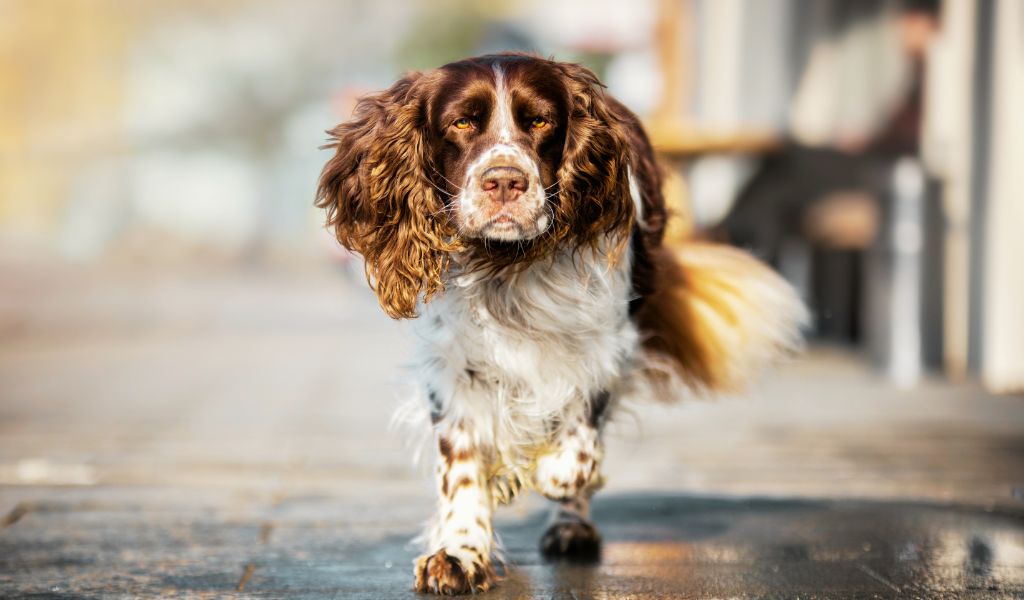Yes. By providing your Springer with good opportunities to burn off energy, working on his social skills and challenging him mentally, you can train him to be a responsible member of society that is not aggressive towards people and other animals.
Springer Spaniels are popular and affectionate dogs known for their intelligence and boundless energy.
However, like any other breed, some Springer Spaniels may display signs of aggression, which can be concerning for owners.
The good news is that with proper training and socialisation, it is possible to address and modify aggressive behaviour in Springer Spaniels.
In this article, we will explore various techniques and approaches to train a Springer Spaniel to not be aggressive, ensuring a harmonious and safe environment for both the dog and its human companions.
Understanding Aggression in Springer Spaniels
Before delving into training methods, it is important to understand the root causes of aggression in Springer Spaniels.
Aggression can stem from various factors, such as fear, territoriality, possessiveness, or even medical issues.
Identifying the underlying cause is crucial in devising an effective training plan.
Fear-Based Aggression: Unraveling the Root Cause
Fear-based aggression is a common type of aggression seen in dogs, including Springer Spaniels.
This aggression arises when a dog perceives a threat or feels cornered, triggering a defensive response.
It is essential to identify the specific triggers that evoke fear in your Springer Spaniel to develop an appropriate training strategy.
Territorial and Possessive Aggression: Establishing Boundaries
Territorial and possessive aggression in Springer Spaniels often manifests when they feel the need to protect their space or belongings.
To curb this behaviour, it is important to establish clear boundaries and teach your Springer Spaniel that resources and space are shared and not to be guarded aggressively.
Medical Issues and Aggression: The Hidden Culprit
Sometimes, aggression in Springer Spaniels may be rooted in underlying medical issues. Pain, discomfort, or hormonal imbalances can contribute to aggressive behaviour.
Therefore, before embarking on any training program, it is vital to rule out any potential health concerns through a thorough examination by a veterinarian.
Training Techniques for a Non-Aggressive Springer Spaniel
Now that we have a deeper understanding of the causes of aggression in Springer Spaniels, let’s explore effective training techniques to promote non-aggressive behaviour.
Socialisation: The Key to a Well-Balanced Springer Spaniel
Socialisation plays a vital role in raising a well-rounded and non-aggressive Springer Spaniel.
Early and positive exposure to various people, animals, and environments helps your dog develop confidence and learn appropriate behaviour in different situations.
Positive Reinforcement: Building Trust and Good Behaviour
Positive reinforcement is a powerful training method that relies on rewarding desired behaviours.
By using treats, praise, and affection, you can reinforce non-aggressive behaviour in your Springer Spaniel.
When your dog displays calm and friendly behaviour, be sure to reward them promptly to create a positive association.
Desensitization and Counterconditioning: Changing Perceptions
For Springer Spaniels with fear-based aggression, desensitization and counterconditioning techniques can be highly effective.
Gradually exposing your dog to the source of fear in a controlled and positive manner can help them overcome their anxiety and develop a more positive association.
Professional Training: Seeking Expert Guidance
In cases where aggression persists despite your best efforts, seeking professional training assistance can be invaluable.
Certified dog trainers experienced in working with aggressive behaviour can assess your Springer Spaniel’s specific needs and provide tailored training techniques to address the aggression effectively.
Consistency and Patience: The Building Blocks of Success
Training a Springer Spaniel to be non-aggressive requires patience, consistency, and time.
Behaviour modification takes time, and setbacks may occur along the way.
It is important to remain dedicated and consistent in your training efforts, ensuring that all family members and caregivers follow the same training guidelines.
FAQ
Here are some frequently asked questions about training a Springer Spaniel to not be aggressive:
Can Springer Spaniels with a history of aggression be successfully trained?
Absolutely! While it may require more time and effort, with proper training techniques and consistency, Springer Spaniels with a history of aggression can be trained to exhibit non-aggressive behaviour.
Is punishment an effective approach to address aggression in Springer Spaniels?
Punishment-based methods can often exacerbate aggression or create fear in dogs. Positive reinforcement and reward-based training techniques are generally more effective and promote a stronger bond between you and your Springer Spaniel.
Should I use a muzzle for my aggressive Springer Spaniel during training?
Muzzles can be useful tools to ensure safety during training sessions, particularly when working with a potentially aggressive dog. However, they should not be a long-term solution and should always be used responsibly and under professional guidance.
How long does it take to see improvements in an aggressive Springer Spaniel?
The timeline for seeing improvements in an aggressive Springer Spaniel can vary depending on the dog and the training methods used. Some dogs may show progress in a matter of weeks, while others may require several months of consistent training.
Can I train my Springer Spaniel to be non-aggressive without professional help?
While professional guidance can greatly assist in addressing aggression, it is possible to make progress with your Springer Spaniel through diligent research, appropriate training techniques, and consistent efforts.
Is it possible for a Springer Spaniel to revert to aggressive behaviour after successful training?
While it is possible for any dog, including Springer Spaniels, to display occasional signs of aggression, proper training and ongoing reinforcement can significantly reduce the likelihood of a relapse.
Conclusion and final thoughts
In conclusion, aggression in Springer Spaniels can be addressed through dedicated training, socialisation, and a patient approach.
By understanding the underlying causes of aggression and employing positive reinforcement techniques, you can train your Springer Spaniel to exhibit non-aggressive behaviour.
Remember to seek professional assistance when necessary, remain consistent in your efforts, and always prioritise the safety and well-being of both your Springer Spaniel and those around them.




